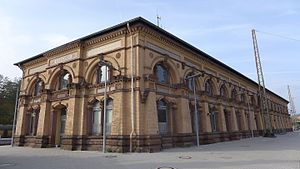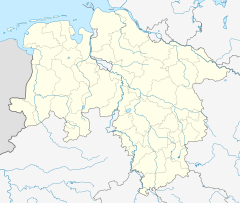Kreiensen stationis aKeilbahnhof( "wedge station" ) inKreiensenin the German state ofLower Saxonyand along withEinbeck-Salzderhelden stationone of two stations in the town ofEinbeck.
| Junction station | |||||||||||||||||||||||||||||||
 Entrance building from the east in 2016 | |||||||||||||||||||||||||||||||
| General information | |||||||||||||||||||||||||||||||
| Location | Bahnhof 1,Kreiensen,Lower Saxony Germany | ||||||||||||||||||||||||||||||
| Coordinates | 51°51′04″N9°58′04″E/ 51.85113°N 9.96788°E | ||||||||||||||||||||||||||||||
| Line(s) | |||||||||||||||||||||||||||||||
| Construction | |||||||||||||||||||||||||||||||
| Architect | Hubert Stier | ||||||||||||||||||||||||||||||
| Other information | |||||||||||||||||||||||||||||||
| Station code | 5892[1] | ||||||||||||||||||||||||||||||
| DS100 code | HK[2] | ||||||||||||||||||||||||||||||
| IBNR | 8000213 | ||||||||||||||||||||||||||||||
| Category | 4[1] | ||||||||||||||||||||||||||||||
| Fare zone | VSN:480[3] | ||||||||||||||||||||||||||||||
| Website | bahnhof.de | ||||||||||||||||||||||||||||||
| History | |||||||||||||||||||||||||||||||
| Opened | 1854 | ||||||||||||||||||||||||||||||
| Services | |||||||||||||||||||||||||||||||
| |||||||||||||||||||||||||||||||
| |||||||||||||||||||||||||||||||
History
editThe first station in theDuchy of Brunswick[4]was established in Kreiensen in 1854. It consisted of station buildings, outbuildings and goods sheds, as well as an extension with ancillary facilities.[5]It became more congested with the opening of theAltenbeken–Kreiensen railwayin 1865. Following the opening of theBrunswick–Bad Harzburg railwayof the Duchy of Brunswick and theVienenburg–Goslar railwayin 1866, new construction at the station began in 1886. Reliefs of theBrunswick Lionon the east side and aPrussian eagleon the west side reflect its joint use by Hanover and Brunswick—theKingdom of Hanoverwas located directly north and south. Master builder Richard Herzig had 35,000 yellow and red facing bricks and 110,000 common bricks delivered.[6]
Since the tracks divided Kreiensen into two areas, a pedestrian bridge was built. It was designed according to the construction principle of Max Möller with fish-bellied support ribs at spans of 124 m and 58 m.[7][8]
In 1923, there was a rear-end collision between two trains travelling at night and 47 people were killed.[9]The collision was initially believed to have killed 100.[10]
In 1956, the world's first track-plan signal box was installed by Siemens.[11]It was able to take over the tasks of three old mechanical signal boxes. Two dispatchers each served half of the station, which was only connected on the south side by three tracks.[12]Anelectronic interlockingthat was remotely controlled by thecontrol centrein Hanover was put into operation on 13 November 2011.[13]
The platforms and canopies were renovated in 2014.
Entrance building
editThe entrance building was built for theHanoverian Southern Railwayto plans by Hubert Stier in 1886-89. This building from theWilhelministperiod is a brick building with facades covered by tiles. Other elements of shaped stone are found in arched profiles and cornices. Formal design tools are used sparingly on the facades.[14]The cladding with ochre-coloured ceramic tiles is complemented with pillars covered with various terracotta reliefs. Plinths and cornices are made of sandstone. Due to its external monumentality, the building does not reflect the townscape, but instead stresses its importance as a railway junction. It contains aFürstenzimmer( "prince's room" ), which was the location of a meeting betweenOtto von Bismarckand TsarAlexander III of Russiain 1889.[15]
It was due to be sold at auction byDB Station & Servicein September 2016.[16]
Operations
editThe operations include freight and passenger trains. The station is a railway junction. It is served mainly byDeutsche Bahn,NordWestBahnandMetronom Eisenbahngesellschaft.It is used in freight operations by theIlmebahnfor shunting. It is also the location of a bus station of theVerkehrsverbund Süd-Niedersachsen.
| Line | Route | Operator |
|---|---|---|
| ICE 24
(some trains) |
Munich–Augsburg–Würzburg–Kassel-Wilhelmshöhe–Göttingen–Kreiensen–Hannover–Lüneburg–Hamburg Hbf–Hamburg-Altona | DB Fernverkehr |
| RE 2 | Uelzen– Celle – Hannover Hbf –Kreiensen–Northeim(Han)– Göttingen | Metronom |
| RB 82 | Bad Harzburg–Goslar– Langelsheim –Seesen–Kreiensen– Northeim (Han) – Göttingen | DB Regio Nord |
| RB 84 | Kreiensen– Holzminden – Bad Driburg(Westf) –Altenbeken(–Paderborn) | NordWestBahn |
In addition, a single train pair operated byDB RegioNord runs via Bad Gandersheim, Seesen andSalzgitter-Badto Brunswick Hbf in the morning.
References
editFootnotes
edit- ^ab"Stationspreisliste 2025"[Station price list 2025](PDF)(in German).DB Station&Service.28 November 2024.Retrieved5 December2024.
- ^Eisenbahnatlas Deutschland (German railway atlas)(10 ed.). Schweers + Wall. 2017.ISBN978-3-89494-146-8.
- ^"VSN Tarifpunktinfo".Verkehrsverbund Süd-Niedersachsen.1 January 2021.Retrieved16 September2021.
- ^"Herzogtum Braunschweig (Landkreis Gandersheim) 1910"(in German).Retrieved15 March2018.
- ^Verhandlungen der Landesversammlung des Herzogtums Braunschweig(in German). Vol. 4. 1866. p. 178.
- ^"unknown".Tonindustrie-zeitung und Fachblatt der Zement-, Beton-, Gips-, Kalk- und Kunststeinindustrie(in German).12:289. 1888.
{{cite journal}}:Cite uses generic title (help) - ^S. Zipkes (1907).Kontinuierliche Balkenbrücken aus Eisenbeton in Theorie und Ausführung(in German). p. 14.
- ^Neuere Bauweisen und Bauwerke aus Beton & Eisen(in German). Vol. 1. W. Ernst & Sohn. 1902.
- ^Pottgiesser (2013).Sicher auf den Schienen(in German). p. 185.
- ^"100 Believed Killed When Two German Trains Collide".da.tj.news.August 1, 1923.Retrieved26 September2023.
- ^Walter Jonas (2001).Elektronische Stellwerke bedienen: der Regelbetrieb(in German). p. 14.
- ^W. Teigeler (1966).Jahrbuch des Eisenbahnwesens(in German). p. 39.
- ^Holger Kötting."List of German signal boxes"(in German).Retrieved15 March2018.
- ^Siegner 1986,p. 341.
- ^Richard Deiss (2014).Palast der tausend Winde und Stachelbeerbahnhof(in German). p. 54.
- ^"Kreienser Bahnhof kommt unter den Hammer".HNA(in German).Archivedfrom the original on 30 August 2016.Retrieved15 March2018.
Sources
edit- Prochnow, Jürgen (2004).100 Jahre Bahnhof Kreiensen. Das Eisenbahnerdorf. Norddeutschlands traditioneller Eisenbahnknotenpunkt(in German).
- Siegner, Klaus (1986).Die Bahnhofsarchitektur Hubert Stiers (1838-1907)(in German). pp. 130ff.
